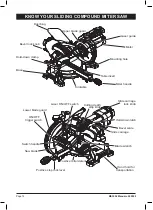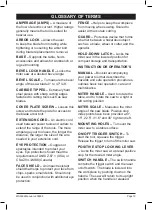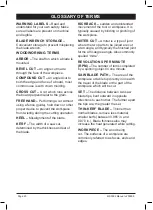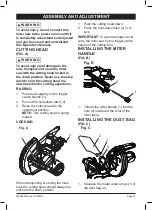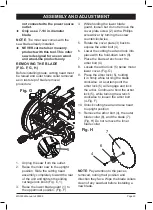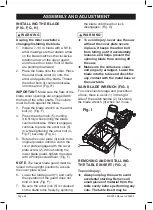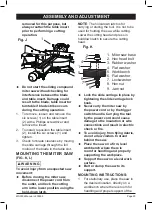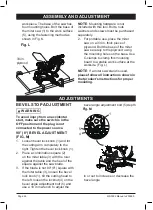
MS3002 Manual v.200909
Page 31
Review the MAINTENANCE and
TROUBLESHOOTING GUIDE for
your miter saw.
To avoid injury or possible death
from electrical shock: Make sure your
fingers do not touch the plug’s metal
prongs when plugging or unplugging
your miter saw. (ELECTRICAL
REQUIREMENTS AND SAFETY)
BEFORE EACH USE, INSPECT
YOUR SAW.
Disconnect the miter saw.
To avoid
injury from accidental starting, unplug
the saw before any adjustments,
including set-up and blade changes.
Compare the direction of rotation
arrow
on the guard to the direction
arrow on the blade. The blade teeth
should always point downward at the
front of the saw.
Tighten the arbor bolt.
Tighten the cover plate screw.
Check for damaged parts.
\
Check for:
Alignment of moving parts
Damaged electric cords
Binding of moving parts
Mounting holes
Function of arm return spring
and lower guard: Push the
cutting arm all the way down,
then let it rise until it stops.
The lower guard should fully
close. Follow instructions in
TROUBLESHOOTING GUIDE
for adjustment if necessary.
Other conditions that may affect
the way the miter saw works.
Keep all guards in place, in working
order and proper adjustment. If any
part of this miter saw is missing,
bent, damaged or broken in any way,
or any electrical parts don’t work, turn
OPERATING SAFELY
the saw off and unplug it.
Replace bent, damaged, missing or
defective parts before using the saw
again.
Maintain tools with care. Keep the
miter saw clean for best and safest
performance. Follow instructions for
lubricating. Do not put lubricants on
the blade while it is spinning.
Remove adjusting wrench from the
tool before turning it on.
To avoid injury from jams, slips,
or thrown pieces, use only
recommended accessories.
Check the dust bag before you work.
Empty the bag if it is more than half-
full.
RECOMMENDED ACCESSORIES
Consult the ACCESSORIES and
ATTACHMENTS section of this
Operator’s Manual for recommended
accessories. Follow the instructions
that come with the accessory. The
use of improper accessories may
cause risk of injury to persons.
Choose the correct 7-1/4 in. diameter
blade for the material and the type of
cutting you plan to do.
Make sure the blade is sharp,
undamaged and properly aligned.
With the saw unplugged, push
the cutting arm all the way down.
Manually spin the blade and check
for clearance. Tilt the power-head to
a 45° bevel and repeat the test.
Make sure the blade and arbor
collars are clean.
Make sure all clamps and locks are
tight and there is no excessive play
in any parts.


